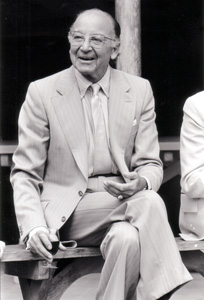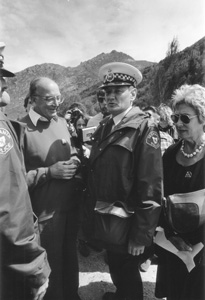
Claudio Alcorso
1913-2000 |
 |
Claudio Alcorso was a
passionate advocate of the Tasmanian 'dolce vita', including
the best of the arts, food & wine, and social and environmental
justice. |
|
|

|
Fleeing Fascist Italy in the 1930s, Claudio Alcorso arrived in
Australia only to find himself interned during World War 2. After
internment, Alcorso moved his successful textile business to Tasmania.
From Hobart, he maintained an active role in the arts, assisting
in the development of the Elizabethan Theatre Trust, the Australia
Council and the Sydney Opera House. In Tasmania, he aided the development
fo the Tasmanian Centre for the Arts and the Sullivan's Cove development,
in which the Haven exhibition will be displayed. He also established
a vineyard outside Hobart, which now includes Museum of Antiquities.
Alcorso was a passionate advocate of Lake Pedder. |

Claudio Alcorso and his wife being arrested
during Franklin demonstration |
- Some excerpts from his book (Claudio Alcorso The Wind You Say:
An Italian In Australia Sydney: Angus & Robertson, 1993):
-
- Fighting to save the Franklin
- With the exception of the uprising at Eureka Stockade, Australia's
history does not include revolutions. The fight to save the Franklin
was a revolution in the new meaning of the term: it involved large
numbers from all over Australia, from all strata of society, who
defied the law and were imprisoned for their actions.
|
- Innovative textile designs
- [Foreword to book of designs A New Approach to Textile Designing
(1946) with designs by Dobell, Preston, Drysdale, Donald Friend,
etc.] The designs reproduced in this book are not only a new approach
to textile designing; they also are the expression of a desire
to introduce creative thought and beauty into the everyday things
of life…
- Dream of Tasmanian small industry
- The Franklin crisis hastened a change in attitudes… The
concept that TASMANIA could become synonymous with QUALITY, and
together with it, the acceptance of the idea that 'small is beautiful',
were being supported by an increasing number of people.
- The Roman villa on the Derwent valley
- [After parents come to Tasmania in 1955] even though we were
ten kilometres upriver, we had cool afternoon sea-breezes in summer
which spoiled the day and more so the lingering hours of twilight,
l'ora che volge al desio (the hour that turns toward
desire), as the poet sang. Amongst all my books I had a copy of
a 1937 Domus, an architectural magazine, with an article
entitled: 'We do not need a new manner of building, we need a
new manner of living'. The article extolled the merits of the
old Roman villa which had an internal, sheltered but open patio
on ground level. I had kept it because I thought that if one day
I would build my home, that would be my model. I could not have
dreamt then of Tasmania, where the climate called for precisely
that sort of house.
- The Koori nation
- In my old age, walking along the natural terrace, or sitting
in the native garden at dusk or early in the morning, when the
water and the trees are stil and I am at peace, I feel kinship
with the previous inhabitants. Their love for the land was more
instinctive than mine, but also my roots go down into the soil.
We restored the land to its original fertility and then brought
it to bear fruit in the vineyard…
The Koori nation were destroyed, a cruel episide in the cruel
history of humanity. More than 100 years later the wind of life
brough me to one of their old, overgrown camping sites. Now I
and my kin are the custodians for Mother Earth of this beautiful
small corner of the world.
|
|
|
